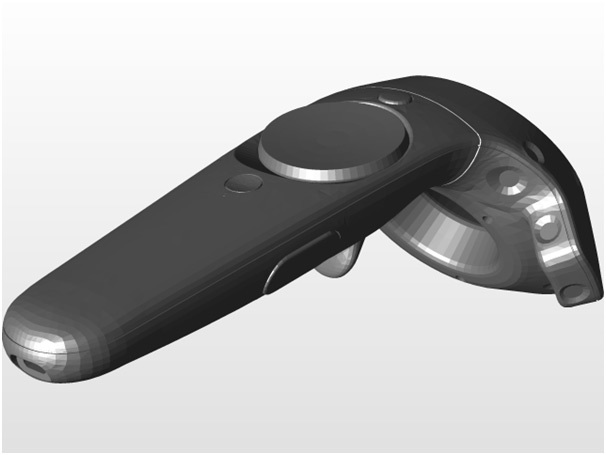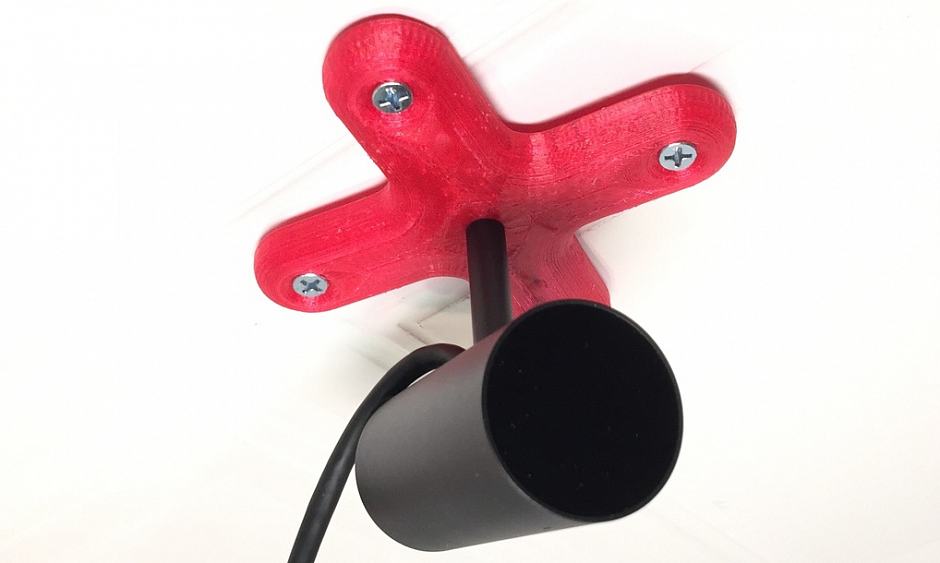Why 3D printing and VR are made for each other

Virtual reality and three-dimensional printing are not just brothers in an era, but integral parts of each other.
The most widely discussed in the media and popular topics related to new technologies, have long been virtual reality and 3D printing. It is not at all surprising what there are two main reasons:
- First of all, these are the closest to the ordinary user and the most applicable in everyday life technologies from innovative ones, this is their main difference from most of the other new products, and they have already become firmly enough in some areas of life.
- Secondly, and not least, these two technologies organically, completely naturally complement each other. And how exactly:
Prototyping new devices
')
Creating prototypes of cases and parts of future devices is not complete without a 3D printer. This was created step by step HTC VIVE

Read more in Makezine . And the model of the VR manipulator for it:

The prototype of the serial model was created as a 3D object, after which it was printed and finalized. This enabled the engineers to hold the product in their hands before the start of production and evaluate its ergonomics and convenience. The same principle was used to create the Surround 360 panoramic camera model (this is an open Facebook project for creating a 3D video camera) with a 360 degree viewing angle:

Additionally, VR is very suitable for sensing volume in spatial 3D modeling: you can simulate a 3D model of a new device on a computer, take a good look at and edit it in virtual space, and then print the prototype of the future device.
Or, on the contrary, scan the existing workpiece, transferring it to a digital format, make the necessary adjustments (which is much simpler and, most importantly, more accurate than on the physical model) and print the new version.
DIY VR devices
DIY (Do-It-Yourself), that is, homemade VR-headsets for smartphones are becoming increasingly popular among 3D printers, because cardboard Google Cardboard is fragile and short-lived, and commercial plastic samples from different manufacturers are often sold at clearly inflated prices. Therefore, an increasing number of enthusiasts print on 3D plastic analogs of Cardboard and other, more advanced models.
At the same time, the models themselves are free, and printing them on a simple FDM 3D printer will be cheaper than buying cardboard glasses.
This is the 3D model of the simplest virtual reality helmet, i.e. VR-headset for smartphone, designed for self-production:

Model VR-headset for self-printing from Damian Szyszkowski
Many are content to print the simplest Google Cardboard, albeit from a more durable than cardboard, material:

VR headset modeled on Google Cardboard on a 3D printer
There are more thoughtful devices, with the possibility of various adjustments and settings, which, however, are just as easy to print and assemble.

Original VR-headset made on a 3D printer
Video showing the assembly of a homemade, printed on a 3D-printer, VR-visor:
To view the free catalog of models for DIY VR devices, please visit www.thingiverse.com
In addition to headsets, there are other virtual reality devices that you can create yourself. A headset or helmet only allows you to immerse yourself in the space created by someone, but there are devices for those who want to create themselves: spherical cameras.
These are special video cameras, the coverage of which allows you to simultaneously capture the entire surrounding space. You can create a spherical camera for shooting VR-shots and commercials, functionally similar to those used for professional three-dimensional shooting of movies with the effect of presence, having printed a special bracket with mounts for GoPro or other miniature cameras.

Spherical frame using multiple Hero3 - Black Mount

Another version of the “spherical” frame for Hero - “ Underwater ”, suitable for underwater shooting
Not everyone is interested in home-made printing, many prefer to use devices developed by professionals, but for such users there is a way to use 3D printing in the field of VR - the creation of non-standard spare parts and unique accessories for VR equipment.
DIY accessories and accessories for VR
New devices appear constantly, and it is expensive and difficult to buy accessories for them - shipping, customs, - all this takes a lot of time and money. Not to mention that not all of them are manufactured and sold by the equipment manufacturers themselves. The way out is simple - you can print, for example, non-standard and not available for sale stands or suspensions for VR-helmets and other components of VR-systems and other interesting accessories that will make the experience of using devices more comfortable and rich.
Here are just a few examples of such devices designed for popular VR-systems, which can be downloaded online and printed independently:

Wall hanger for HTC Vive controllers

Charging stand for two controllers HTC Vive

Adapter “rifle” for the controller HTC Vive, for games like The Nest

Wall mount for linkbox (switching unit) system HTC Vive

Adapter to connect the Vive base station to any standard tripod

HTC Vive Helmet Wall Mount

Details for connecting the HTC Vive VR helmet with more convenient than the complete headband

Oculus Rift Wall Mount

Ceiling, it is also a wall mount for the Rift sensor , can also be used as a stand for placement on horizontal surfaces

Simple suspension for vertical storage of the Oculus Rift helmet on furniture or walls

Desktop stand for VR helmet Oculus Rift
In this way, you can create any accessory, any part and any device that you can think of to your devices. It is enough to create in the editor or simply download the necessary part in digital form, download it into your 3D printer and print it.
Ideas - to life
You should pay attention to the fact that most of the functions and capabilities of three-dimensional printers are quite accessible on not the most expensive models of devices. For example, there are devices that are quite affordable for an ordinary person, moreover, they are of high quality and produce a more than decent result.
One of the best examples of such equipment is the Wanhao Duplicator i3 printer, which has already earned a good reputation :

A higher class device, but also easy to use and maintain - the famous Picaso 3D Designer Pro 250 :

Such an apparatus is enough for the manufacture of household items, souvenirs, parts of mechanisms and even some more technological products. Up to use in the invention.
If you need more accuracy and convenience of work, then you can choose a 3D printer more expensive, but also obviously higher class. For example - Formlabs Form 2 :

This is practically a professional model of a 3D printer, which provides resolution and speed that are inaccessible to more budget models.
Fewer restrictions remain for such a promising duet as 3D and VR, because the printing and scanning devices are improving all the time, the quality of products is increasing, and the range of materials used for printing is growing day by day. In addition to plastics and food materials, wood and glass, metals and ceramics are already available for use. As well as virtual reality devices, giving an ever more natural presence effect and more and more detailed image and interactive features. In the near future, these two technologies, together, great change the usual picture of the world. What they have already begun to do.
In conclusion, a demonstration of the joint work of these technologies - a full-featured VR helmet printed on 3D, equipped with its own screens and not requiring the use of a smartphone:
Want more interesting news from the world of 3D technology?
Subscribe to us in the social. networks:




Source: https://habr.com/ru/post/397371/
All Articles